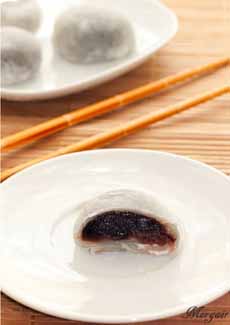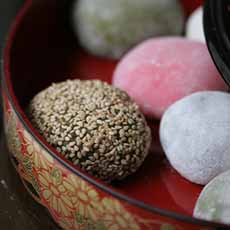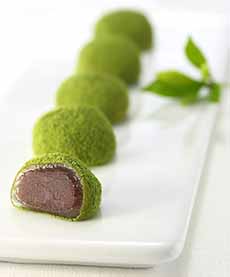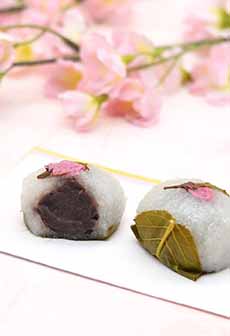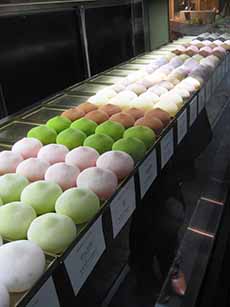A Traditional Mochi Recipe For National Mochi Day
|
|
How about a mochi recipe for August 8th, National Mochi Day (pronounced MOE-chee)? We love the ancient Japanese treat, small cakes of two bites. consisting of a round pouch of rice dough, traditionally filled with red beans or other paste. The recipe below is just such a treat, a variety called daifuku mochi that has a center of red bean paste (photo #1—daifuku means “filled”). Written references to mochi go as far back as 794 C.E. > Here’s the history of mochi and the 1993 newcomer, mochi ice cream. According to Google Trends, March 2021 saw searches for “mochi” increase by 285%, the highest on record. We just checked on Google, and there were 86,300,000 results! Mochi also appears as a gender-neutral name on BabyNames.com. Minamoto Kitchoan, a purveyor of beautiful wagashi (Japanese confections) and our first introduction to the wondrous world of mochi. They have locations in Beverly Hills, Honolulu, London, New York, San Francisco, Singapore, Taipei, and Tokyo. And of course, there’s online shopping. If you don’t want to make your own mochi, head there to look at the selection. Traditional mochi is made from a short-grain japonica glutinous (sticky) rice called mochigome. (It’s gluten-free*.) It’s cooked, pounded, and mixed with water, sugar, and cornstarch to form a dough that’s kneaded and wrapped around a center. The result: a soft, pillowy, soft, chewy style of rice cake, each about three bites’ worth. They’re delicious with your beverage of choice or by themselves, like cookies. Food 101: Although mochi is called a rice cake, it’s technically a cookie. The difference: Cookies are finger food, cake requires a fork. The rice dough is mixed with flavorings and/or food color and molded into the desired shape. Round is traditional, although some pastry artists turn the balls of mochi into little pieces of art for extra delight: bunnies, chicks, peaches, and pumpkins, for example (photo #6). Mochi can be sweet or savory, and there are numerous varieties of both (see the bakery case in photo #7). A few examples: It’s used in religious rituals in the Shinto religion, as well. (Gee, didn’t we say that two days ago about lassi?) Ice cream-filled mochi are a recent arrival, invented as a “mother of invention” in Los Angeles in 1993 (see the history). Once the word got out beyond the Asian community there, sales grew exponentially. Today, you can find ice cream mochi in many supermarkets and at Trader Joe’s, in many flavors. Are you ready to make mochi? The first step is to make traditional mochi. After you’ve gotten used to the dough, you can fill it with ice cream, PB&J, whatever! To celebrate National Mochi Day, the team at Meal Delivery Experts sent us this simple recipe to make at home. Surprise your family, friends, and/or work colleagues. Have a tea party (or an iced tea party, in this summer weather). This recipe is daifuku mochi, filled with red bean paste (perhaps the Japanese version of a thumbprint cookie with raspberry jam?). Instead of red bean paste, some people use the milder white bean paste. You can get the specialty ingredients at an Asian market or online. Or… Here’s how to make red bean paste at home. If you wish you can color your dough, and/or roll the finished mochi in sesame seeds (photo #2) or matcha powder (photo #3). In Japan, you’ll find them in a broader variety of toppings, such as kinako (toasted soy bean powder), or mixed with yomogi (mugwort herb) [source]. Here’s a video. 1. WRAP the red bean paste in aluminum foil and place it in the freezer until solid, at least 1 hour. 2. MIX the glutinous rice flour and green tea powder thoroughly in a microwave-safe bowl. Stir in the water, then the sugar, and mix until smooth. 3. COVER the bowl with plastic wrap and microwave for 3 minutes 30 seconds. Meanwhile… 4. REMOVE the red bean paste from the freezer and divide it into 8 equal balls. Set aside. 5. REMOVE the rice flour mixture from the microwave. Stir, then heat, covered, for another 15 to 30 seconds. 6. DUST a work surface with cornstarch. Roll about 2 tablespoons of the hot rice flour mixture into a ball. Flatten the ball and place one ball of frozen red bean paste in the center. Pinch and press the dough around the bean paste until it is completely covered. Sprinkle with additional cornstarch and place the mochi, seam-side down, in a paper muffin liner to prevent sticking. 7. REPEAT Step 6 to make the remaining mochi. Enjoy them with a delicious cup of tea (or coffee, or milk, or “straight”). |
|
|
________________ *Although it sounds like glutinous rice has gluten, it doesn’t. The term “glutinous” refers to the glue-like, sticky texture of the rice after it’s cooked.
|
||
